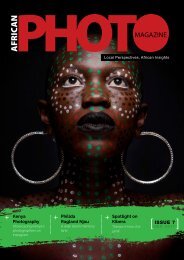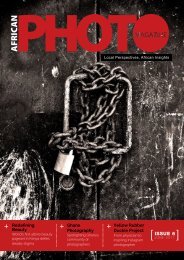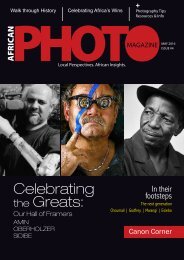African Photo Magazine Issue #8
We are particularly delighted to publish, in this issue, photographers showcasing studio photography talent that echoes the work of one of Africa’s greats, Malick Sidibé (1936–2016). Photographers Hassan Hajjaj, Omar Diop and Samuel Fosso have stayed true to the photographic style that made Mr Sidibé’s work legendary. The portraitures are uniquely stylish and follow signature themes that clearly identify each photographers artistic bent. The work of this trio speaks to the heart of this publication, the genesis of which was to not only celebrate contemporary African photography but to reach back and illuminate the artistry and creativity of our forefathers and those that came before us, and to never forget that we stand on the shoulders of giants.
We are particularly delighted to publish, in this issue, photographers showcasing studio photography talent that echoes the work of one of Africa’s greats, Malick Sidibé (1936–2016). Photographers Hassan Hajjaj, Omar Diop and Samuel Fosso have stayed true to the photographic style that made Mr Sidibé’s work legendary. The portraitures are uniquely stylish and follow signature themes that clearly identify each photographers artistic bent. The work of this trio speaks to the heart of this publication, the genesis of which was to not only celebrate contemporary African photography but to reach back and illuminate the artistry and creativity of our forefathers and those that came before us, and to never forget that we stand on the shoulders of giants.
Create successful ePaper yourself
Turn your PDF publications into a flip-book with our unique Google optimized e-Paper software.
the Actual<br />
Life of<br />
I am so appalled by some know-nothing<br />
comments about Winnie Madikizela<br />
Mandela, that I need to weigh in…<br />
writes award-winning writer, and<br />
Nelson Mandela’s authorised biographer,<br />
Charlene Smith.<br />
W i n n i e<br />
Madikizela<br />
Mandela<br />
by Charlene Smith<br />
I<br />
f Madiba could forgive and honour<br />
her, and then not punish white South<br />
<strong>African</strong>s for what we put her and<br />
others like her through, how DARE<br />
you judge her?<br />
Winnie Mandela, when I first met her in<br />
1976, was the most beautiful woman I’d<br />
ever seen – tall, imperious, with a gorgeous<br />
deep voice and a low sexy laugh. I<br />
interviewed her after she had to stop work<br />
for a cobbler, because security police<br />
harassment was so intense, business to<br />
the store fell off.<br />
It had been this way for 13 years, ever<br />
since the jailing of her husband, Nelson<br />
Mandela in 1963. Now that she has died<br />
the clichés about her life are rolling in thick<br />
and fast. How eager we are to forget, and<br />
in refusing to remember we perpetuate<br />
the harm she experienced in life.<br />
The Truth and Reconciliation Commission<br />
(TRC) hearings in 1998 found she played<br />
a role in the murders of Stompie Seipei<br />
(13), evidence suggested she stabbed him<br />
twice in the throat, and the deaths of Lolo<br />
Sono, and others. In 1992, she was charged<br />
with ordering the death of Dr. Abu-Baker<br />
Asvat. A decade later she was charged<br />
and convicted on multiple counts of fraud<br />
and theft, but never served jail time.<br />
And yet, she deserves our empathy and I<br />
will tell you why.<br />
30 africanphotomagazine ISSUE 8 December 2018 31










